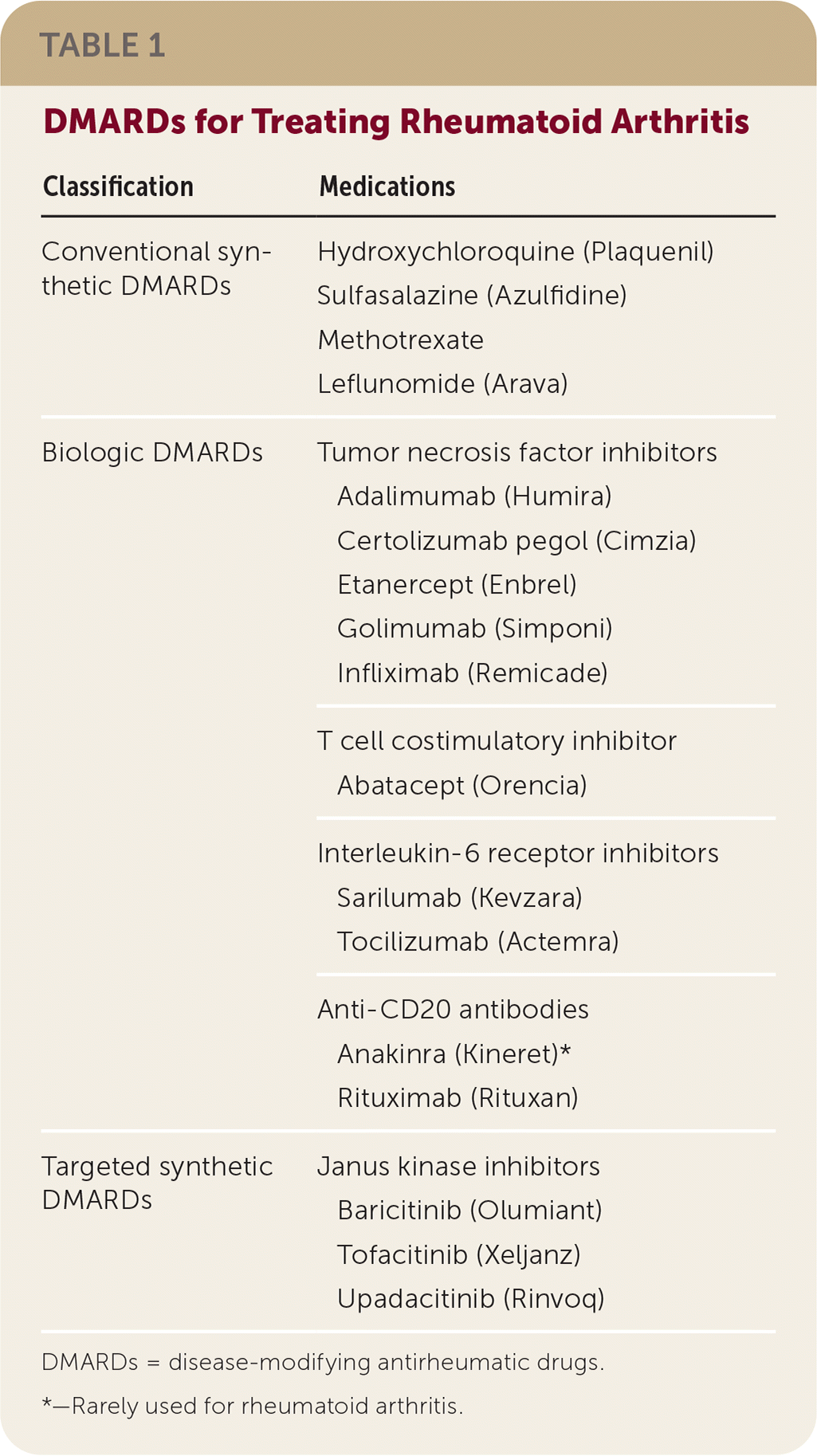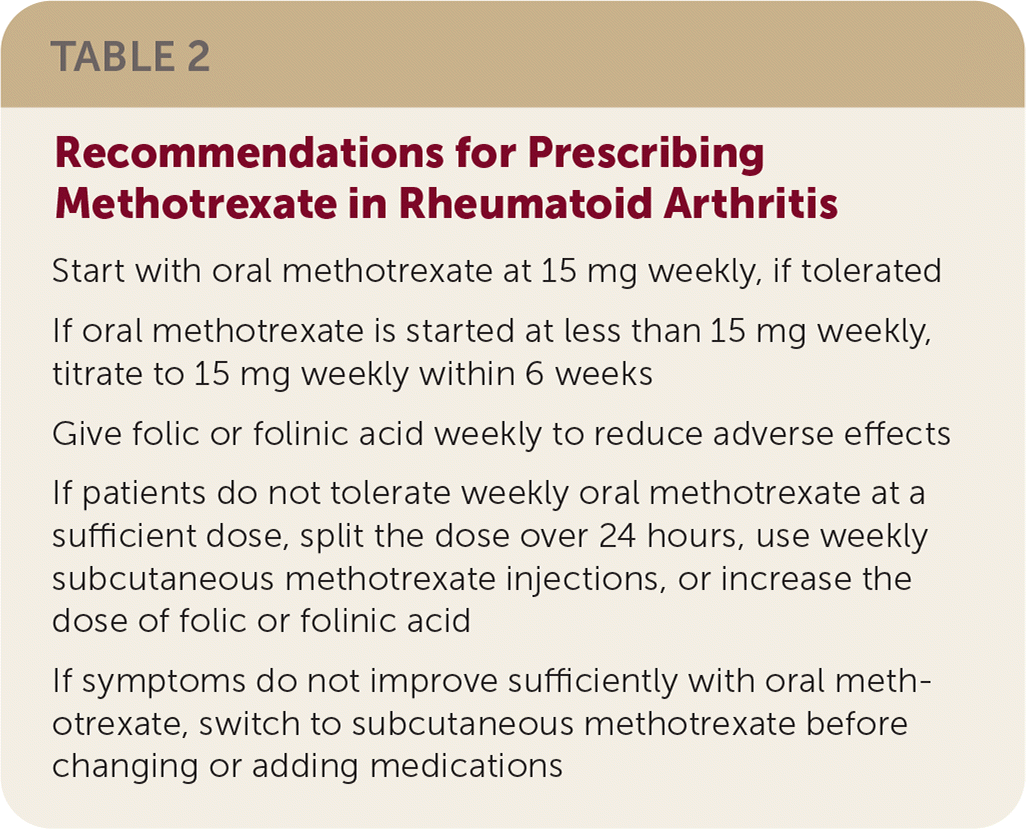
Am Fam Physician. 2022;106(3):340-342
Author disclosure: No relevant financial relationships.
Key Points for Practice
• In patients with rheumatoid arthritis, hydroxychloroquine is recommended for initial treatment in those with low disease activity.
• Methotrexate is recommended for initial treatment of patients with rheumatoid arthritis and moderate or high disease activity.
• Rheumatoid arthritis treatment should be targeted to a standardized disease activity scale.
• In patients with rheumatoid arthritis who do not achieve low disease activity with methotrexate, triple therapy with the addition of sulfasalazine and hydroxychloroquine is as effective as adding a biologic or targeted synthetic medication, although response will be slower.
From the AFP Editors
Disease-modifying antirheumatic drugs (DMARDs) are the key to treating rheumatoid arthritis, and timely initiation can prevent joint damage. Although the multiple classes of DMARDs can make treatment decisions challenging, family physicians often prescribe these medications. DMARDs are categorized as conventional synthetic (csDMARDs), biologic (bDMARDs), and targeted synthetic (tsDMARDs). Table 1 lists DMARDs approved for rheumatoid arthritis treatment. The American College of Rheumatology (ACR) published updated guidelines focused solely on medical treatment of rheumatoid arthritis.

| Classification | Medications |
|---|---|
| Conventional synthetic DMARDs | Hydroxychloroquine (Plaquenil) Sulfasalazine (Azulfidine) Methotrexate Leflunomide (Arava) |
| Biologic DMARDs | Tumor necrosis factor inhibitors Adalimumab (Humira) Certolizumab pegol (Cimzia) Etanercept (Enbrel) Golimumab (Simponi) Infliximab (Remicade) |
| T cell costimulatory inhibitor Abatacept (Orencia) | |
| Interleukin-6 receptor inhibitors Sarilumab (Kevzara) Tocilizumab (Actemra) | |
| Anti-CD20 antibodies Anakinra (Kineret)* Rituximab (Rituxan) | |
| Targeted synthetic DMARDs | Janus kinase inhibitors Baricitinib (Olumiant) Tofacitinib (Xeljanz) Upadacitinib (Rinvoq) |
Initial Treatment of Rheumatoid Arthritis
For patients without previous DMARD use, treatment recommendations are stratified by disease activity using patient ratings and inflammation measures.
Low Disease Activity
With low disease activity (see Editor's Note for a measurement scale), consider, in this order, initial treatment with hydroxychloroquine (Plaquenil), sulfasalazine (Azulfidine), methotrexate, and leflunomide (Arava). Hydroxychloroquine is better tolerated and has a better risk profile than the others. Sulfasalazine is recommended over methotrexate and leflunomide because it causes less immunosuppression. Methotrexate is recommended over leflunomide because of lower cost and better dosing flexibility.
Moderate to High Disease Activity
With moderate to high disease activity, methotrexate is the best initial treatment for rheumatoid arthritis. Methotrexate has stronger evidence of disease-modifying activity than the other csDMARDs, hydroxychloroquine and sulfasalazine. Although some bDMARDs and tsDMARDs have evidence of better outcomes, methotrexate is safe and effective, with convenient dosing and low cost. Combination therapy is not recommended for initial treatment because it is unnecessary for many patients and incurs higher toxicity and cost. Recommendations for methotrexate therapy are summarized in Table 2.

| Start with oral methotrexate at 15 mg weekly, if tolerated |
| If oral methotrexate is started at less than 15 mg weekly, titrate to 15 mg weekly within 6 weeks |
| Give folic or folinic acid weekly to reduce adverse effects |
| If patients do not tolerate weekly oral methotrexate at a sufficient dose, split the dose over 24 hours, use weekly subcutaneous methotrexate injections, or increase the dose of folic or folinic acid |
| If symptoms do not improve sufficiently with oral methotrexate, switch to subcutaneous methotrexate before changing or adding medications |
Neither short- nor long-term glucocorticoid therapy is recommended as standard initial treatment, although some patients may require short-term glucocorticoid therapy in addition to DMARDs to aid with symptom control.
Treat-to-Target Therapy
Because initial treatment depends on disease activity measured by a standard scale, optimal doses should be determined by target disease activity. Although the evidence is strongest for patients treated with csDMARDs alone, treat-to-target therapy is recommended for all patients. An initial target of low disease activity is recommended because remission may not be achievable for many patients.
Adjusting Antirheumatic Therapy
For patients without adequate symptom control on methotrexate alone, another medication should be added. Studies demonstrate that triple therapy, a combination of methotrexate, hydroxychloroquine, and sulfasalazine, is as effective as adding a bDMARD or tsDMARD. The ACR recommends adding a bDMARD or tsDMARD based on a more rapid improvement in symptoms and the greater persistence of therapy in observational studies. Yet, the cost of triple therapy is significantly less and may be appropriate for some patients.
If adding a bDMARD or tsDMARD does not improve symptoms to the targeted disease activity level, switching to a different class of bDMARD or tsDMARD is recommended based on very low-quality evidence. Switching DMARD medications or adding another DMARD is preferred to adding or continuing glucocorticoids, including intraarticular glucocorticoids.
Tapering or Discontinuing DMARD Therapy
Because stopping all DMARDs is associated with a moderate to high risk of a symptom flare-up and potential for irreversible damage, a minimum of one DMARD is recommended in all patients. For patients with symptoms at the targeted level for less than six months, continuing all DMARDs at their current dose is recommended. Because the risk of a flare-up is highest when lowering the dose or stopping DMARDs, any dose reductions should be gradual. For patients taking triple therapy, discontinuing sulfasalazine should be considered before hydroxychloroquine. If patients are taking methotrexate and a bDMARD or tsDMARD, tapering methotrexate should be considered first because the bDMARD or tsDMARD was added after methotrexate alone was ineffective.
Coexisting Conditions
For patients with subcutaneous rheumatoid nodules, methotrexate is recommended as initial therapy unless nodules progress. Switching to a different DMARD is then recommended.
Although preexisting lung disease is a risk factor for methotrexate-related pneumonitis, the risk is uncertain and other therapies can also worsen lung disease. Methotrexate is recommended with careful monitoring.
For patients with nonalcoholic fatty liver disease, methotrexate should be restricted to those with normal liver enzymes and no history of fibrosis.
For patients with preexisting heart failure or who develop heart failure, tumor necrosis factor inhibitor therapy should be avoided because of risk of worsening heart failure.
In patients who have had a serious infection within the previous 12 months, bDMARDs, tsDMARDs, and glucocorticoids should be avoided.
The views expressed are those of the author and do not necessarily reflect the official policy or position of the Department of the Navy, Uniformed Services University of the Health Sciences, U.S. Department of Defense, or the U.S. government.
Editor's Note: The delays associated with rheumatology referrals encourage many of us to initiate treatment for rheumatoid arthritis, and some family physicians lack access to rheumatology specialty care altogether. A 2019 ACR guideline reviewed rheumatoid arthritis disease activity measures and graded the Clinical Disease Activity Index (CADI) as the strongest of their five recommended scales.1 The CADI is easy to access, is the quickest to complete (two to five minutes), requires no laboratory measurements, and grades disease activity as remission, low, moderate, and high. The ACR is clear on the initial recommended medications—hydroxychloroquine for low disease activity and methotrexate for moderate or high disease activity. For patients with uncontrolled symptoms while taking methotrexate, triple therapy with conventional synthetic DMARDs is consistently effective. Methotrexate, sulfasalazine, and hydroxychloroquine can all be easily prescribed and monitored with little or no guidance from a rheumatologist and are much safer, better tolerated, and less expensive than biologic or targeted synthetic DMARDs.—Michael J. Arnold, MD, Contributing Editor
Reference: England BR, Tiong BK, Bergman MJ, et al. 2019 Update of the American College of Rheumatology recommended rheumatoid arthritis disease activity measures. Arthritis Care Res (Hoboken). 2019;71(12):1540-1555.
Guideline source: American College of Rheumatology
Evidence rating system used? Yes
Systematic literature search described? Yes
Guideline developed by participants without relevant financial ties to industry? No
Recommendations based on patient-oriented outcomes? Yes
Published source: Arthritis Care Res (Hoboken). July 2021;(73)7:924–939
Available at: https://onlinelibrary.wiley.com/doi/10.1002/art.41752
